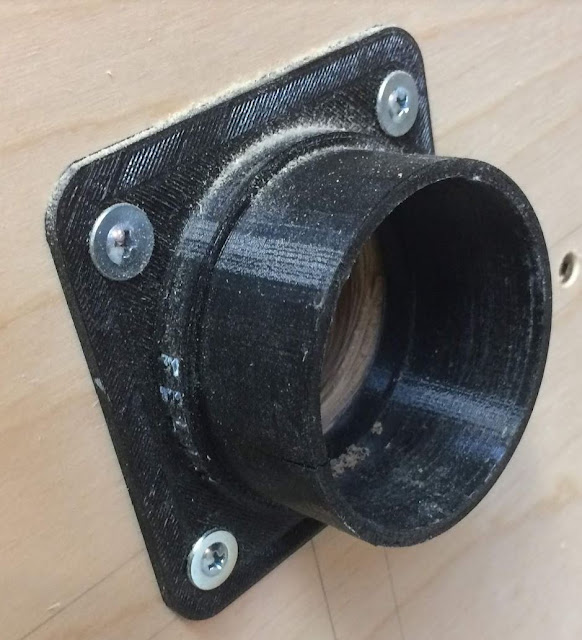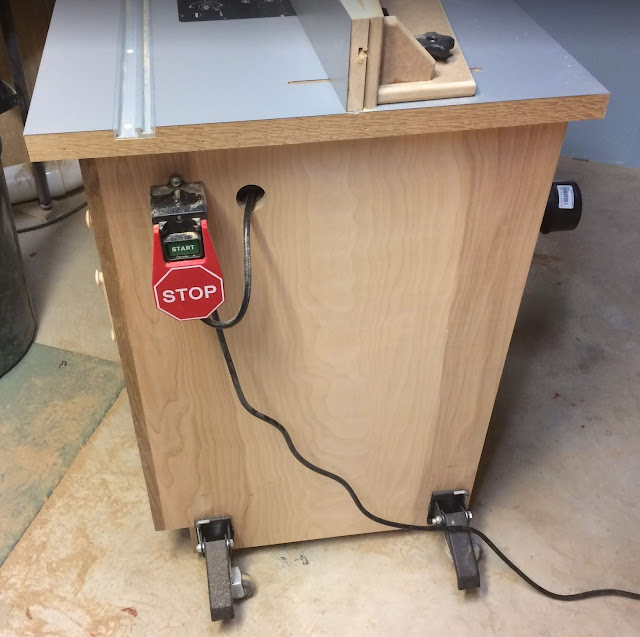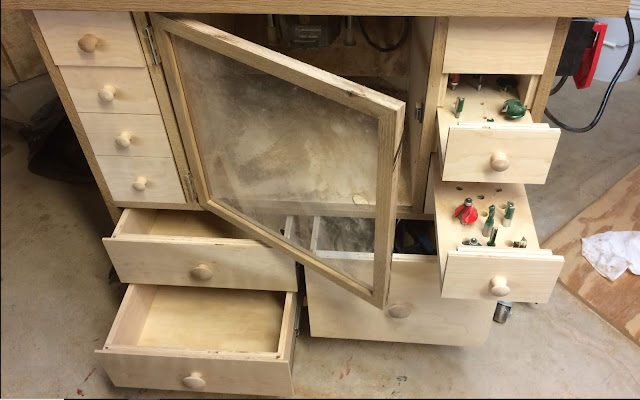Step 1: Rough milling
The first step to any woodworking project is to break the purchased boards down into slightly over sized parts. These parts are left to acclimate to shop humidity and temperature. Once they've had a chance for all the tensions to balance they get run through the jointer and planer process again to reflatten the boards.
To be honest I typically eschew this process and just straight to finished sizes and if a board warps too much I make a new one. I am going to make an exception for this project since the precision and more importantly the consistency is extremely important.
I'm going to put a border around my hexes so I'll also mill some 1/8" thick walnut strips. I'll need enough to cover all the faces so that's 114 linear feet of 1" wide strips. If I can get a thick enough walnut board I'll just rip them off 1/8" at a time.
To be honest I typically eschew this process and just straight to finished sizes and if a board warps too much I make a new one. I am going to make an exception for this project since the precision and more importantly the consistency is extremely important.
I'm going to put a border around my hexes so I'll also mill some 1/8" thick walnut strips. I'll need enough to cover all the faces so that's 114 linear feet of 1" wide strips. If I can get a thick enough walnut board I'll just rip them off 1/8" at a time.
Step 2: Set the final height of the hexagons
At this point I have a stack of 8/4 maple boards that are of various thicknesses. The first step is the pare them down to the finished thickness. You can be as exact in this step as you want. If you are a touch compulsive feel free to be super precise. If you are more of the wild-and-free sort feel free to be a little sloppy. The rest of the process will result in a perfect hexagon regardless.
Whatever the thickness you have coming out of the planer at the end of this step will be the final height of the hexagon column.
What is most important is that after this step the planer should not be adjusted again until all the hexagons are completely finished. The planer height is defining the height of the hexagon if it gets moved your hexagons will not go together evenly.
Whatever the thickness you have coming out of the planer at the end of this step will be the final height of the hexagon column.
What is most important is that after this step the planer should not be adjusted again until all the hexagons are completely finished. The planer height is defining the height of the hexagon if it gets moved your hexagons will not go together evenly.
Step 3: Making the boards hexagonal
At this point I have my boards flattened and the final height set. The next step is to transform these boards into hexagons. I use three tools for this step: Planer, Table Saw and my Wixey Digital Angle Gauge.
What is most critical is that the height of all parallel faces of the hexagon are identical. It is is slightly less critical but still important that the angles on the sides are as close to 60 degrees as possible.
 |
| Figure 1: Reference hexagon |
Step 2a: Clipping the corners
I use my Wixey Digital Angle Gauge to set the angle on the table saw blade to 60 degrees. I suppose if you didn't have one of these you could use a drafting square. I do have one so I use it.
I set my fence to take a little bit off the corner of the blanks. I flip the work piece upside down and to the same to the other corner on the same side. I keep creeping the fence inward until the two sides - 5 & 6 - meet at a point.
Step 2b: Finish the hexagon
The next step is to set the table saw fence to complete the hexagon shape. I also make sure sides 1 and 4 are a little longer. I aim for between 1/32" and 1/16" extra to take off later. The goal is to not cut the blank too small but not leave more than can be removed cleanly in a single pass in the planer in the next step.
Use sample pieces to dial in the correct fence settings.
My example image shows the rough blank being the perfect size to minimize waste. In practice I normally make the rough blanks extra wide to make sure I get a full-sized hexagon. Better to have a little more waste rather than waste the entire blank.
Step 2b: Notes
- I mark my blanks with numbers on the end as shown in the images above so that in each step I an working on the identical face on each blank.
- If your blade isn't at 60 degrees exactly, that's okay so long as you keep you blanks oriented identically. i.e. when gluing up butcher block always have the '1' face pointing towards the same side. This works because the angles will be complementary.
- Lock the angle adjustment on the table saw blade as you don't want to change it until you're done with making all the hexagons.
Step 3: Plane Perfect
This step makes the hexagon heights all consistent. Send the blanks through the planer to clean faces 2 & 3.
Step 4: Adding borders to the hexagons
We've got perfect hexagons now but we have to mess them up in order to add a border. To provide a border around our hexagons we're going to add veneer to the outside faces. Then when we cut the column into shorter segments and line them up we'll have a nice hexagonal pattern with borders.
The process is to shave a little off the hexagon with the table saw to make room for the veneer, glue a strip on, then clean up using the table saw and planer. Then repeat.
The process is to shave a little off the hexagon with the table saw to make room for the veneer, glue a strip on, then clean up using the table saw and planer. Then repeat.
Reset the table saw fence so that the blade trims a little bit off of one face of the hexagonal column. It doesn't matter how much you trim it just needs to be less than the thickness of one of the strips you cut in step 3. However much you trim off will be the thickness of the border.
Do not adjust the table saw fence again until you're done. Since my fence will slip if I put enough pressure against it, I plan to add additional clamping to keep it from slipping.
My image shows me starting with face 5 but really any face will work.
Step 4a: Trim off one face
My image shows me starting with face 5 but really any face will work.
Step 4b: Veneer
The previous step made the hexagon slightly shorter in one dimension. Now we add a strip of veneer to make the hexagon slightly taller in that same dimension.Step 4c: Cleanup veneered side
This step brings us back into a perfect hexagon shape again. We use the planer to bring the height of the hexagon back to the correct height. Using our initial face as an example we pass the column through the planer with face 2 down and face 5 up.We then need to clean up the veneer tabs sticking out to the sides. One of them we'll clean up using the planer. The other one we'll get when we trim the next face for veneering.
Step 4d: Rinse and Repeat
Rotate column and repeat steps 4a-4c until all sides are veneered.Step 5: Cutting slices
Now it is just a matter of cutting slices off the hexagonal column. I'm going to make a custom sled that cradles the hex column to reduce tear out.
Summary
So I've got plans for how to make my table top. I've worked through the design steps. What I don't have is the base that holds the table off the floor. I'd like to carry the hexagon theme into the base. Maybe I'll make the legs hexagonal...
The table needs storage. I haven't decided how much, or what form.
But at least I know how I'll make the top.


























